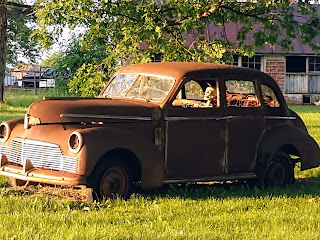So I've been through all the counties of Ohio now; and today I went through all the counties I'd planned to get to in Indiana. The original plan is to get one more county in Kentucky, and a few in southern Missouri, before heading home. That may change: after I post this blog I'm going to get on Google Maps and decide just how badly I want those remaining counties, compared to just how badly I want to get home.
Ohio was ... well, not very exciting. Pretty enough, like England after a good ironing. Everything green, farm after farm, copses of trees surrounded by fields, a stream here, a stream there, quaint little towns each with its Marathon station and six churches. The highways run straight from one to the next, a legacy of the Northwest Ordinance of 1787 (that's the law that gave us townships, ranges and sections, and drew all those nearly-straight lines on the map). Dull, orderly, settled.
Indiana is similar, although as you get close to the Ohio River it gets a little disorderly, and that's where I was today, for the most part. I found myself driving alongside the path of the old Whitewater Canal, which depended on the contours of the land and so wasn't all that straight, and the road alongside respects the hills and streams, too, and while not nearly as much fun as driving in eastern Kentucky, in the Appalachian moun
tains, it was a lot more fun than driving from, say, Indianapolis to Springfield.
 |
| abandoned lock on the Miami & Erie Canal |
When I was a schoolboy I was taught that the State of New York dug the Erie Canal and commerce was magically transformed. I never knew, though, that there were other canals in the US. A lot of them. The success -- the immediate success of the Erie spurred the construction of canals all across the settled parts of the country, which meant Ohio and Indiana and Illinois. So today I saw remains of two of those: the Miami and Erie Canal, in Ohio, and the Whitewater, in Indiana.

| Headquarters of the Whitewater Canal Company (1842) |
Of course, the coming of the railroad doomed canal operations to the dustiest pages of history, but for a while there, maybe 30 years, they were the Wave of the Future, and huge amounts of money were invested in their construction and maintenance. It's too bad they didn't survive long enough to become tourist attractions, like canals in Europe.
I saw some graphs on TV this evening that make me want to get home. It was a series of four graphs, representing the corona virus pandemic in four industrialised nations: Italy, Spain, France, and the US. In each of the European countries, the infection rates shot up early, then went steadily down, back almost to zero. But in the US, it shot up to a peak, dipped slightly, and has continued at the rate of roughly 20,000 new infections a day ever since. We are making no headway in countering this disease in this country. Of course, most of the infections are coming from places where people are packed closely together: nursing homes, prisons, meat plants and other labor-intensive industrial operations (and soon, Trump rallies); but people who work at those places go home and spread the infection to their families, and they go to church on Sunday and spread the infection to their coreligionists, and they go to the takeout counter at the local restaurant and spread the infection to the workers there, who then go home and spread it to their families, their coreligionists, their friends ... more slowly, perhaps, but as relentlessly. And since, from what I've seen on this trip, very few people are taking the whole thing seriously, I am not as willing to be out among these people as I was when I thought San Antonio's response to the problem was normal, i.e., everybody in a mask, everybody keeping distance.
I guess our best hope for the future is that all the people who go to the Trump rallies next week in Tulsa and Mobile, and where ever else he's going to be, infect each other and die before the November election. That way we'll have a better chance of getting a competent government in place come January, and then things can start to improve. An awful thing to wish for, and I don't honestly wish for it. But there would be a certain poetic justice, a cosmic irony if you will, if it happened that way.
Oh, and once again, here's a link to all the pictures from this trip.











